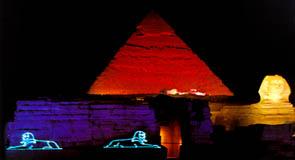|
Giza
Age of the Sphinx
PAGE 3
|
Heavy
and frequent rain he judged not to have fallen since well before
Egypt's dynastic history began in about 3100 BC. He pointed
to certain mud-brick tombs at Saqqara of the Archaic Period
(Dynasties I and II) that show no signs of erosion by exposure
to rains to point his conclusion that his rain-weathered Sphinx
must be older than the beginnings of Egyptian civilization.
Dr Schoch noted that there is some evidence for a period of
heavier (if sporadic) rains between about 4000 BC and 3000 BC
and that, as we have seen, even in Old Kingdom times until about
2300 BC, conditions were less arid in Egypt than they have been
since; but he did not want to assign the better part of his
rainwater weathering of the Sphinx to these periods since he
judged the degree of erosion to demand a long period of heavy
and regular rainfall since the carving of the monument. In a
note at the end of his KMT article, he acknowledged the observation
that burial in wet sand might have contributed to the erosion
if it could be shown to have occurred, but again he clearly
thought this mechanism inadequate to explain the very great
erosion of the body.
In wishing to push back the date of the carving (and the commencement
of erosion) into the wetter period before 5000 BC, Dr Schoch
was fortified by the findings of the seismic research conducted
at the Sphinx at the same time as his own work. Data collected
by detecting the reflected and refracted effects of sledge-hammering
a steel plate on the floor of the Sphinx enclosure suggested
to him and his seismographer colleagues that there is deep subsurface
dissolution of the limestone bedrock beneath the floor of the
enclosure, indicative again of long exposure at some time in
the past (since cutting) to heavy rainfall.

Son
et lumiere at Giza, with laser projection of sphinxes
that once stood in these positions in front of Khafre's
valley temple beside the temple of the Great Sphinx. |
Dr Schoch further noted that the limestone core blocks of
the Sphinx temple and of the valley temple of Khafre were
cut from rock removed from the Sphinx enclosure, and that
they show a similar pattern of erosion to the body of the
Sphinx and the Sphinx enclosure walls.
|
He went so far as to think that the granite casing applied
to these core blocks was cut to fit their highly eroded surfaces.
In this way, he arrived at a two-stage theory of construction
history for these temples: in his view they were originally
made, like the Sphinx, thousands of years before Khafre came
on site to find them badly eroded and ready for restoration
with new granite facings. (Dr Schoch acknowledged that the
head of the Sphinx is certainly an Old Kingdom carving.)
Egyptologists were bound to be tickled at the thought that
the ancient Egyptians might have gone to the trouble of laboriously
carving hard granite to fit the randomly eroded surfaces of
much softer limestone blocks that could easily have been dressed
to take the granite facings, even assuming for the sake of
argument that they had found the temples already old and in
need of repair. As with the temples, so with the Sphinx. Dr
Schoch suggested that Khafre or some other Old Kingdom ruler
had found a monument badly in need of restoration and proceeded
to clad much of it in repair blocks as long ago as 2500 BC.
But in fact, the Egyptologists had concluded that parts at
least of the Sphinx, for instance its right hind paw and maybe
the slope of its back behind the head- dress, were from the
start built on to the core of living rock. Dr Zahi Hawass
has been prepared to think that the original construction
work went further than that, but Dr Lehner has concluded that
most of the add-on work at the Sphinx belongs to New Kingdom
and later times.
The seismic work around the Sphinx gave Dr Schoch an additional
line of reasoning in discussion of a possible date for the
original carving of the monument. Seismography suggested that
subsurface erosion runs less deep behind the rump of the Sphinx
to the west than it does on the northern, southern and eastern
sides. This in turn suggested either that the rump of the
Sphinx was not carved as early as the rest or that it was
originally only just freed from the rock without a floor surface
behind it, which was subsequently cut out by Khafre or someone
else during the Old Kingdom.
As with the pyramids, it might give a slightly too early date
for the work, since mortar may contain organic material (wood,
in fact) that was already a century or two old when it was
used to make the mortar. But in any case, such a dating would
only apply to the fitting (or refitting) of the repair blocks.
Much of that work almost certainly occurred during the New
Kingdom and later times; and, if some of it was done in Dynasty
IV, its dating would still not establish the date of the original
carving of the monument.
|